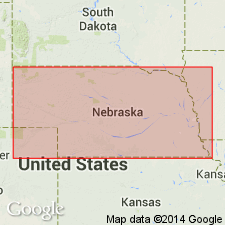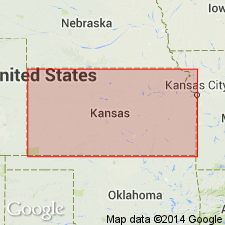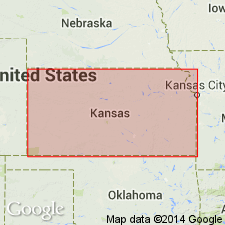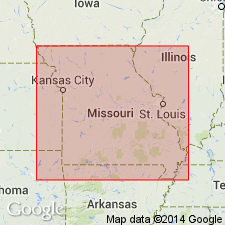
- Usage in publication:
-
- Eudora shale bed
- Modifications:
-
- Original reference
- Dominant lithology:
-
- Shale
- Limestone
- AAPG geologic province:
-
- Nemaha anticline
Summary:
Pg. 12, 26, 27, 31, 34. Eudora shale, in lower part of Stanton limestone member, consists of alternating thin beds of bluish to black shale, and bluish limestones. Total thickness 9+/- feet. Underlies Stoner limestone and overlies Meadow limestone as here redefined. Age is Pennsylvanian. Report includes cross sections, graphic sections.
Named from good exposures east of Eudora, Douglas Co., KS.
[GNC remark (ca. 1935, US geologic names lexicon, USGS Bull. 896, p. 705): Foregoing definition was used by R.C. Moore, C.O. Dunbar, G.E. Condra, and others.]
Source: US geologic names lexicon (USGS Bull. 896, p. 705); GNC KS-NE Pennsylvanian Corr. Chart, sheet 1, Oct. 1936; supplemental information from GNU records (USGS DDS-6; Denver GNULEX).

- Usage in publication:
-
- Eudora shale member
- Modifications:
-
- Overview
- AAPG geologic province:
-
- Nemaha anticline
Summary:
In Kansas Geol. Survey Bull., no. 21, pt. 1, May 15, 1935, p. 76-79, N.D. Newell defined Eudora shale member of Stanton limestone of Johnson and Miami Counties, northeastern Kansas, as consisting of 4 to 11 feet of black carbonaceous shale, overlain by Olathe limestone member and underlain by Captain Creek limestone member.
See also Newell, Jour. Geol., v. 44, no. 1, 1936, p. 23-31; "Modern classifications of the Pennsylvanian rocks of eastern Kansas and southeastern Nebraska," compiled by M.G. Wilmarth, Secretary of Committee on Geologic Names, USGS unpub. corr. chart, Oct. 1936, 2 sheets.
Source: US geologic names lexicon (USGS Bull. 896, p. 705).

- Usage in publication:
-
- Eudora shale member
- Modifications:
-
- Overview
Summary:
Pg. 32. Eudora shale member of Stanton limestone. In Nebraska, underlies Dyson Hollow limestone zone or member (new) of Stoner limestone. Persistent in Kansas, Missouri, southeastern Nebraska, and south-central Iowa. Age is Late Pennsylvanian (Missourian). Type locality stated.
Type locality: west of north-south side road where it joins the east-west Highway about 2 mi east of Eudora, Douglas Co., KS.
Source: US geologic names lexicon (USGS Bull. 1200, p. 1293-1294).

- Usage in publication:
-
- Eudora shale member
- Modifications:
-
- Overview
Summary:
Pg. 68 (fig. 14), 118. Eudora shale member of Stanton limestone. Overlies Captain Creek limestone member; underlies Stoner limestone member (this is classification agreed upon by State Geological Surveys of Iowa, Kansas, Missouri, Nebraska, and Oklahoma, May 1947). Lower part consists of black fissile shale or in some places of dark clay shale containing thin carbonaceous layer; upper part is greenish- to bluish-gray and is soft and clayey. Thickness ranges from only 1 foot in some northern outcrops to 50 feet in part of Montgomery County, Kansas. Age is Late Pennsylvanian (Missourian).
Source: US geologic names lexicon (USGS Bull. 1200, p. 1293-1294).

- Usage in publication:
-
- Eudora shale member
- AAPG geologic province:
-
- Cherokee basin
Summary:
(Paleozoic Era; Pennsylvanian System by J.M Jewett, H.G. O'Connor, and D.E. Zeller, p. 33.) Eudora Shale Member of Stanton Limestone of Lansing Group. Thickness 2 to 11 feet in eastern Kansas, except in Montgomery County where it ranges from 0 to 70 feet. In most exposures the middle part of the Eudora comprises 1 to 5 feet of grayish-black fissile shale that contains small phosphatic nodules. The grayish-black shale overlies a thin bed of greenish-gray calcareous shale and is overlain by 1 to 6 feet of light- to dark-gray shale. In Montgomery County, the member is chiefly gray calcareous and fossiliferous shale locally containing a few inches to a few feet of grayish-black fissile shale near its base. Overlies Captain Creek Limestone Member and underlies Stoner Limestone Member, both of Stanton. Age is Late Pennsylvanian (Missourian).
Source: Publication.

- Usage in publication:
-
- Eudora shale member
- Modifications:
-
- Overview
Summary:
Pg. 98. Eudora Shale Member of Stanton Formation of Lansing Group. Originally called the "Eudora shale of Stanton limestone member of Lansing formation" (Condra, 1930). Moore (1936, Kansas Geol. Survey Bull., no. 22, p. 133) located the type section at a "...road-cut exposure near northeast corner of sec. 4, T. 13 S., R. 21 E., 1.5 miles northeast and 2 miles east of Eudora [Douglas County], Kansas." Thompson (1995, Missouri Div. Geol. and Land Survey, v. 40 (2nd ser.) revised, p. 118) stated "The Eudora Shale Member...is a fissile shale, which is black in the basal and middle parts and gray in the upper part. Its average thickness is about 5 feet." The Eudora Shale Member overlies the Captain Creek Limestone Member, and underlies the Stoner Limestone Member of the Stanton Formation. Age is Late Pennsylvanian (Missourian). Report includes nomenclature history.
Source: Publication.
For more information, please contact Nancy Stamm, Geologic Names Committee Secretary.
Asterisk (*) indicates published by U.S. Geological Survey authors.
"No current usage" (†) implies that a name has been abandoned or has fallen into disuse. Former usage and, if known, replacement name given in parentheses ( ).
Slash (/) indicates name conflicts with nomenclatural guidelines (CSN, 1933; ACSN, 1961, 1970; NACSN, 1983, 2005, 2021). May be explained within brackets ([ ]).

